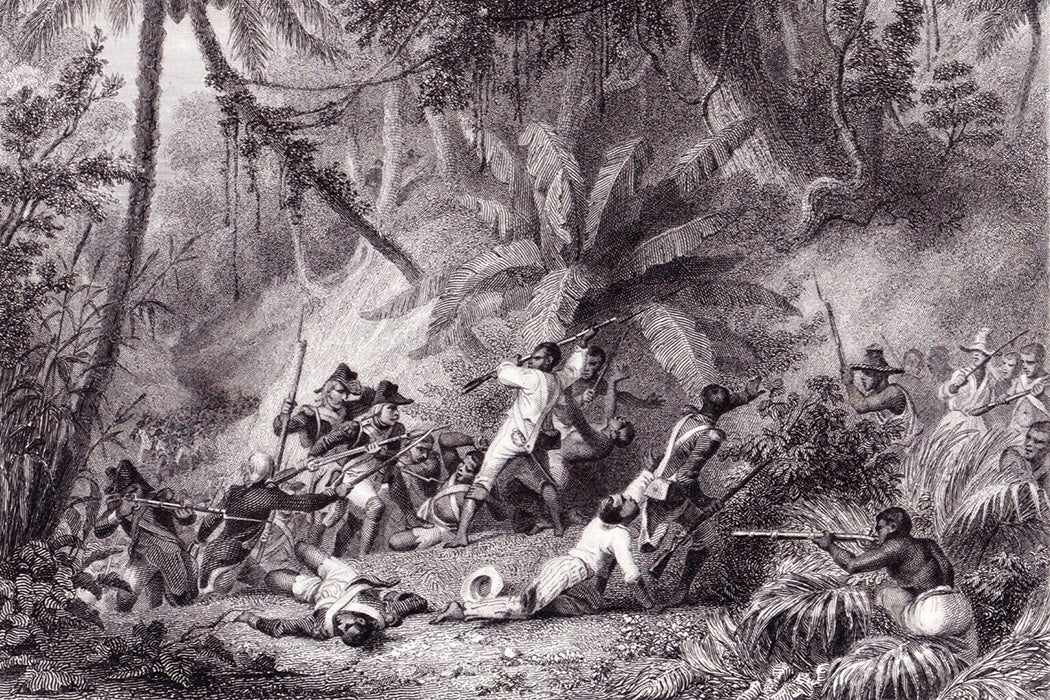Just six years after the United States shook off its colonial ruler, rebels in the French colony of St. Domingue staged their own uprising. From 1791 to 1804, revolutionaries fought the French forces, finally establishing the Republic of Haiti. As historian Gerald Horne writes, far from recognizing a kinship with their fellow freedom fighters, leaders of the early US republic were terrified about the domestic implications.
George Washington expressed concern about the potentially international “spirit of revolt among the blacks.” Once started, he mused, “where it will stop, it is difficult to say.”
His fear, of course, was that it would not stop before it hit his own country. Just days after the outbreak of fighting, the governor of South Carolina wrote Washington to warn him how “nearly similar” conditions in St. Domingue were to those in his state, where white enslavers were also outnumbered by potentially rebellious Africans.
With the US and the European powers vying for control of various parts of the Caribbean and North America, Horne writes, each feared that a rival would ally with the Haitian rebels. Such an alliance would be powerful not only because revolutionary leader Toussaint Louverture commanded an army in the tens of thousands, but also because of its potential to gain local recruits. Leaders including John Adams warned that a force of Black soldiers landing in Virginia or South Carolina would immediately gain the support of enslaved people there. Britain faced similar worries regarding Jamaica and its other Caribbean colonies.
US and British leaders expressed concern about the continued importation of enslaved Africans, who would further unbalance the local populations. This played a role in both countries’ abolition of the importation of African slaves in the early nineteenth century.
As Haiti’s revolution progressed, European enslavers fleeing for the US helped reinforce the political constituency for pro-slavery policies. They also shared gruesome stories about the fate white people might face if enslaved Africans gained any power.
Meanwhile, Horne writes, enslaved Black Haitians brought to the mainland by their enslavers also stories of the revolution, which proved inspiring. Jefferson wrote in 1802 that the fighting in Haiti “appears to have given considerable impulse to the minds of slaves in different parts of the US.” Many uprisings in US states drew inspiration from Haiti.
Weekly Newsletter
The Black republic also provided material support to the international abolitionist cause. Under Toussaint, Haitian forces sometimes seized slave ships and diverted the Africans to serve in the Haitian Army. Haiti became a headquarters for abolitionist organizing in the Americas.
In the US, Horne writes, pro-slavery forces aligned themselves with anti-Haiti politics. In 1844, the US supported the Dominican Republic in winning independence from Haiti, and Secretary of State John C. Calhoun, a prominent defender of American slavery, sent arms there in the hopes of overthrowing Haiti’s government.
Up to, and even after, the Civil War, the politics of race in the US remained closely tied to its relationship with Haiti.
Teaching Tips
Primary Sources from JSTOR:
- “Le Code Noir” or “Black Code” (1767)
- Mémoire en faveur des gens de couleur ou sang-mêlés de St.-Domingue, & des autres isles françoises de l’Amérique, adressé à l’Assemblée nationale (1789)
- Réflexions sur le code noir, et dénonciation d’un crime affreux, commis à Saint-Domingue (1790)
- Letter to Charles Humbert Marie Vincent from Toussaint Louverture (October 21, 1797)
- An historical survey of the French colony in the island of St. Domingo (1797)
- Message from the President of the United States, transmitting certain documents on the subjects of the insurrection in Pennsylvania, the renewal of commerce with St. Domingo, and the mission to France (December 5, 1799)
Support JSTOR Daily! Join our membership program on Patreon today.







